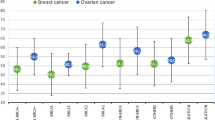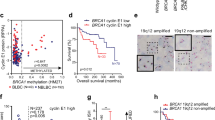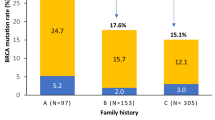Abstract
41 breast cancer or breast-ovarian cancer families, including 12 families with at least one affected first-degree male relative, were screened for mutations in the BRCA2 gene. Mutations had not been found in the BRCA1 gene of these families. Chemical cleavage of Mismatch was used to identify nucleotide changes within large PCR products (average size 1.2 kb) that carried strand-specific fluorescent end-labels. 15 amplicons were sufficient to scan 18 exons, including the large exon 11. The remaining 9 small exons were examined by Denaturing Gradient Gel Electrophoresis. The high sensitivity of this approach was documented by the detection, in these 41 patients, of all 9 exonic single nucleotide polymorphisms reported with heterozygosity >0.1. Truncating BRCA2 mutations were found in 7 of the 41 families. 3 of them were in the group of 12 families comprising cases of male breast cancer. Since the methods used here have no bias for particular types of mutations, these data confirm the high proportion of frameshifts among mutations in BRCA2. However, relevant single nucleotide substitutions were also found: one resulting in a stop codon and another one, present in a male patient, was the previously reported change Asp2723His, that affects a highly conserved region of the BRCA2 protein. This study indicates a BRCA2 contribution of 10% (95% CI 2.5–17.5) to our original cohort of 59 breast-ovarian cancer families, whereas the contribution of BRCA1 had been estimated at 46% (95% CI 33–59). © 2001 Cancer Research Campaign
Similar content being viewed by others
Article PDF
Change history
16 November 2011
This paper was modified 12 months after initial publication to switch to Creative Commons licence terms, as noted at publication
References
Connor F, Smith A, Wooster R, Stratton M, Dixon A, Campbell E, Tait TM, Freeman T and Ashworth A (1997) Cloning, chromosomal mapping and expression pattern of the mouse Brca2 gene. Hum Mol Genet 6: 291–300
Easton DF, Bishop DT, Ford D and Crockford GP (1993) Genetic linkage analysis in familial breast and ovarian cancer: results from 214 families. The Breast Cancer Linkage Consortium. Am J Hum Genet 52: 678–701
Ford D, Easton DF, Stratton M, Narod S, Goldgar D, Devilee P, Bishop DT, Weber B, Lenoir G, Chang-Claude J, Sobol H, Teare MD, Struewing J, Arason A, Scherneck S, Peto J, Rebbeck TR, Tonin P, Neuhausen S, Barkardottir R, Eyfjord J, Lynch H, Ponder BA, Gayther SA and Zelada-Hedman M (1998) Genetic heterogeneity and penetrance analysis of the BRCA1 and BRCA2 genes in breast cancer families. The Breast Cancer Linkage Consortium. Am J Hum Genet 62: 676–289
Gad S, Aurias A, Puget N, Mairal A, Schurra C, Montagna M, Pages S, Caux V, Mazoyer S, Beusimon A and Stoppa Lyonnet D Colour bar coding the BRCA1 gene on combed DNA: a useful strategy for detecting large gene rearrangements. Genes Chromosomes Cancer,
Gayther SA, Mangion J, Russell P, Seal S, Barfoot R, Ponder BA, Stratton MR and Easton D (1997) Variation of risks of breast and ovarian cancer associated with different germline mutations of the BRCA2 gene. Nat Genet 15: 103–105
Griffais R, Andre PM and Thibon M (1991) K-tuple frequency in the human genome and polymerase chain reaction. Nucleic Acids Res 19: 3887–3891
Marston NJ, Richards WJ, Hughes D, Bertwistle D, Marshall CJ and Ashworth A (1999) Interaction between the product of the breast cancer susceptibility gene BRCA2 and DSS1, a protein functionally conserved from yeast to mammals. Mol Cell Biol 19: 4633–4642
McAllister KA, Haugen-Strano A, Hagevik S, Brownlee HA, Collins NK, Futreal PA, Bennett LM and Wiseman RW (1997) Characterization of the rat and mouse homologues of the BRCA2 breast cancer susceptibility gene. Cancer Res 57: 3121–3125
Rahman N and Stratton MR (1998) The genetics of breast cancer susceptibility. Annu Rev Genet 32: 95–121
Sharan SK and Bradley A (1997) Murine Brca2: sequence, map position, and expression pattern. Genomics 40: 234–241
Stoppa-Lyonnet D, Laurent-Puig P, Essioux L, Pages S, Ithier G, Ligot L, Fourquet A, Salmon RJ, Clough KB, Pouillart P, Bonaiti-Pellie C and Thomas G (1997) BRCA1 sequence variations in 160 individuals referred to a breast/ovarian family cancer clinic. Institut Curie Breast Cancer Group. Am J Hum Genet 60: 1021–1030
Tavtigian SV, Simard J, Rommens J, Couch F, Shattuck-Eidens D, Neuhausen S, Merajver S, Thorlacius S, Offit K, Stoppa-Lyonnet D, Belanger C, Bell R, Berry S, Bogden R, Chen Q, Davis T, Dumont M, Frye C, Hattier T, Jammulapati S, Janecki T, Jiang P, Kehrer R, Leblanc JF and Goldgar DE (1996) The complete BRCA2 gene and mutations in chromosome 13q-linked kindreds. Nat Genet 12: 333–337
Unger MA, Nathanson KL, Calzone K, Antin-Ozerkis D, Shih HA, Martin AM, Lenoir GM, Mazoyer S and Weber BL (2000) Screening for genomic rearrangements in families with breast and ovarian cancer identifies BRCA1 mutations previously missed by conformation-sensitive gel electrophoresis or sequencing. Am J Hum Genet 67: 841–850
Verpy E, Biasotto M, Meo T and Tosi M (1994) Efficient detection of point mutations on color-coded strands of target DNA. Proc Natl Acad Sci USA 91: 1873–1877
Verpy E, Biasotto M, Brai M, Misiano G, Meo T and Tosi M (1996) Exhaustive mutation scanning by fluorescence-assisted mismatch analysis discloses new genotype-phenotype correlations in angiodema. Am J Hum Genet 59: 308–319
Wagner TM, Hirtenlehner K, Shen P, Moeslinger R, Muhr D, Fleischmann E, Concin H, Doeller W, Haid A, Lang AH, Mayer P, Petru E, Ropp E, Langbauer G, Kubista E, Scheiner O, Underhill P, Mountain J, Stierer M, Zielinski C and Oefner P (1999) Global sequence diversity of BRCA2: analysis of 71 breast cancer families and 95 control individuals of worldwide populations. Hum Mol Genet 8: 413–423
Welcsh PL, Owens KN and King MC (2000) Insights into the functions of BRCA1 and BRCA2. TIG 16: 69–74
Wooster R, Bignell G, Lancaster J, Swift S, Seal S, Mangion J, Collins N, Gregory S, Gumbs C and Mickelm G (1995) Identification of the breast cancer susceptibility gene. BRCA2 Nature 378: 789–792
Author information
Authors and Affiliations
Rights and permissions
From twelve months after its original publication, this work is licensed under the Creative Commons Attribution-NonCommercial-Share Alike 3.0 Unported License. To view a copy of this license, visit http://creativecommons.org/licenses/by-nc-sa/3.0/
About this article
Cite this article
Pages, S., Caux, V., Stoppa-Lyonnet, D. et al. Screening of male breast cancer and of breast-ovarian cancer families for BRCA2 mutations using large bifluorescent amplicons. Br J Cancer 84, 482–488 (2001). https://doi.org/10.1054/bjoc.2000.1627
Received:
Revised:
Accepted:
Published:
Issue date:
DOI: https://doi.org/10.1054/bjoc.2000.1627
Keywords
This article is cited by
-
Difficulties in finding DNA mutations and associated phenotypic data in web resources using simple, uncomplicated search terms, and a suggested solution
Human Genomics (2011)
-
Male breast cancer: is the scenario changing
World Journal of Surgical Oncology (2008)
-
Significant contribution of large BRCA1 gene rearrangements in 120 French breast and ovarian cancer families
Oncogene (2002)



